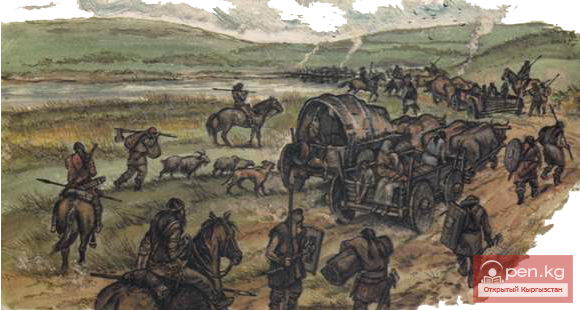
The Struggle of the Kyrgyz Against the Uyghur Kaganate
After the eastern Turks, who rose up against the Chinese, restored their state, the Yenisei Kyrgyz became one of their serious opponents. They joined a coalition of nomadic tribes supported by the Tang Empire. Following this, the eastern Turks defeated the Teleuts led by Baz-kagan, and it was then that the Kyrgyz kagan Bars-beg became their main adversary in Central Asia. In 693, the army of the eastern Turks, led by Kapagan-kagan, launched a military campaign against the Kyrgyz but was unable to defeat them. After this, the eastern Turks preferred to conclude a dynastic alliance with the Kyrgyz, marrying the niece of Kapagan-kagan to the Kyrgyz kagan Bars-beg (Maloe, 1951, p. 38). Bars-beg secured recognition of his kagan title from the eastern Turks and the conclusion of a dynastic alliance, while not being restricted in foreign policy. In 707, 709, and 711, he sent Kyrgyz embassies to China, even though the eastern Turks were at war with the Chinese during those years. According to the eastern Turks, at that time the rulers of the Kyrgyz, the Tabgachs (Chinese), and the Turgesh united against the Turkic kagan and were ready to destroy him. The army of the eastern Turks suddenly attacked the Kyrgyz and dealt them a heavy defeat in Cherni Sunga, in the southern part of the Minusinsk Basin. Kagan Bars-beg was killed; a stone symbolizing this Kyrgyz kagan was erected at the memorial complex built in honor of Kapagan-kagan (Maloe, 1951, pp. 39, 41). On his burial mound, in the area around Lake Altyn-Kel, a commemorative stele was installed with an inscription (Klyashtorny, 2006, p. 340).
The Minusinsk Basin was effectively conquered by the eastern Turks. On the territory of the Middle Yenisei Valley, their monuments spread: memorial complexes of the nobility, stone sculptures, and burials with horses (Khudyakov, 1979, p. 206). However, the Kyrgyz Kaganate managed to maintain a certain degree of independence. In 722-724, its embassies visited the court of the Chinese emperor three times, and the Kyrgyz envoys Juily Ping-hezhun Sygin and Isibo Bishi Sygin were awarded honorary Chinese titles (Suprunenko, 1974, p. 241). In 751, the Kyrgyz, along with the Chik, Oghuz, and Karluk tribes, rose against the expansion of the Uyghurs, who proclaimed the creation of the Uyghur Kaganate. The Uyghurs managed to defeat the "flying detachments of the Kyrgyz and then defeat the Karluks" (Khudyakov, 1980, p. 153). In 758, according to the Uyghurs, they "conquered" the state of the Yenisei Kyrgyz, after which Kyrgyz envoys "could no longer penetrate" into China (Bichurin, 1998, p. 363). It is likely that the Kyrgyz fell under the dependence of the Uyghur kagans, but their statehood was not liquidated. Nevertheless, the ruler of the Kyrgyz state was forced to renounce the title of "kagan" and received a new title "Pitsye Tungye Gin," or "Pitsye-tegin," i.e., not an independent sovereign, but a prince (Bichurin, 1998, p. 363). In 795, the kagan Kutlug from the Ediz tribe came to power, ousting the representatives of the kagan lineage. The Kyrgyz did not recognize the new kagan and revolted (Khudyakov, 1978, p. 137), but the Uyghurs triumphed over the rebelling Kyrgyz, whose ruler was forced to renounce the title of "kagan" once again and accept the title of "Ajo" (Bichurin, 1998, p. 360). This title, which was characteristic only of the Yenisei Kyrgyz, likely corresponded to elteber - the ruler of a separate domain, not claiming to be the supreme ruler of all Central Asia.
What do the ancient Kyrgyz kurgans speak of??















































